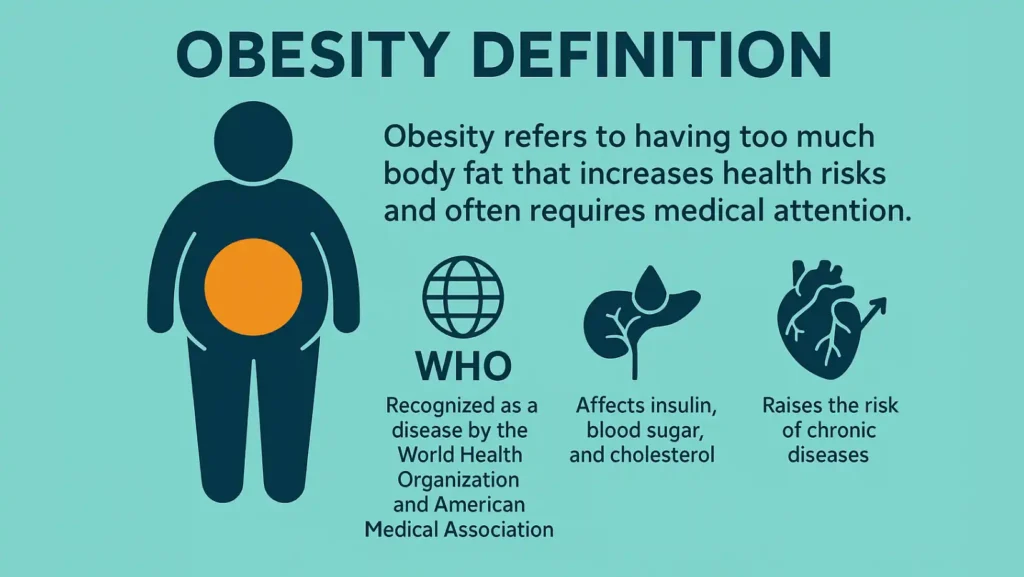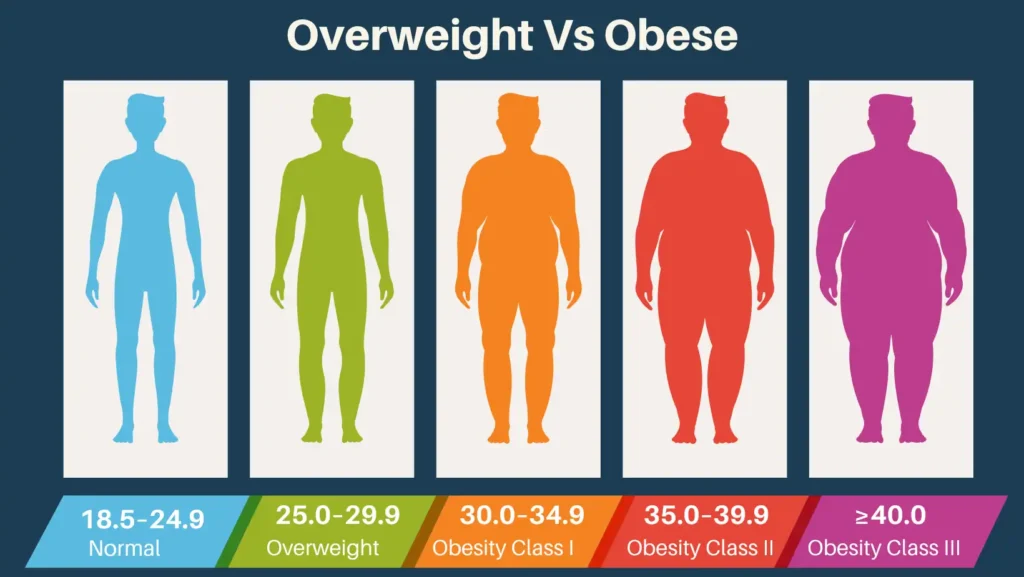Obesity and overweight are often mixed up in daily conversation. Both terms sound alike, but in healthcare they mean different things. Knowing the difference between overweight and obesity is key to understanding health risks, prevention, and treatment.
Table of Contents
ToggleDoctors and researchers use simple tools like BMI to sort body weight, but health goes beyond numbers. Let’s break it down with clear definitions, causes, risks, and when to seek help.
Definitions And Weight Classifications
Overweight Definition
Overweight means a person carries extra body weight compared to what is considered a healthy weight range for their height. This weight may come from body fat, muscle, bone, or even water. Overweight is not always harmful, but it is a signal that health risks could increase if the weight rises further.
Children, teens, and adults have different charts to decide overweight. For adults, overweight is classified when BMI falls between 25 and 29.9. For kids, doctors use age- and sex-specific growth charts from the CDC.
Obesity Definition

Obesity definition refers to having too much body fat that increases health risks and often requires medical attention. Obesity is not just a cosmetic issue. It is recognized as a disease by the World Health Organization (WHO) and the American Medical Association. Obesity changes how the body handles insulin, blood sugar, and cholesterol. It also raises the risk of chronic diseases such as diabetes, heart disease, and some cancers.
BMI: Overweight Vs Obese

The bmi overweight vs obese measure is a global standard. The body mass index (BMI) is calculated as weight in kilograms divided by height in meters squared. It provides a quick way to group people into categories of weight classification.
Here’s how BMI sorts adults:
| BMI Range | Weight Classification |
| 18.5–24.9 | Normal (Healthy weight) |
| 25.0–29.9 | Overweight |
| 30.0–34.9 | Obesity Class I |
| 35.0–39.9 | Obesity Class II |
| ≥40.0 | Obesity Class III (Severe) |
This table shows the difference between overweight and obese. A BMI of 29.5 places someone in the overweight category, while 30.1 moves them into obesity. That small shift has a big impact on health planning.
Still, BMI is not perfect. It does not measure body fat percentage (BFP) directly. For example, athletes with high muscle mass may appear obese on BMI charts but have very low body fat. That is why doctors look at more than BMI before making treatment decisions.
Causes Of Overweight And Obesity
The causes of overweight and obesity are complex. Weight gain is not simply eating more than you burn. Many factors interact, from food and lifestyle to genes and the environment.
- Diet and Nutrition
Calorie-dense foods, sugar-sweetened drinks, and processed snacks are major drivers. A diet low in fiber and high in fast food makes it easier to gain weight. - Exercise and Physical Activity
A lack of movement lowers calorie burn. Desk jobs, long screen time, and limited outdoor play add to the problem. Daily exercise is one of the best weight loss strategies. - Sleep and Stress
Poor sleep raises hunger hormones like ghrelin and lowers fullness signals like leptin. Stress boosts cortisol, which encourages fat storage, especially belly fat. - Genetics and Family History
Genes control how we store and burn calories. If parents are obese, the chance is higher for children to be overweight. Still, genes alone do not cause obesity. - Medical Causes and Medicines
Some medicines like steroids or antidepressants can lead to weight gain. Hormonal disorders such as hypothyroidism or polycystic ovarian syndrome can add risk. - Social and Environmental Factors
Limited access to fresh food, unsafe neighborhoods, and low-income settings often push people toward cheap, high-calorie meals. This ties into public health and obesity, since environment shapes habits. - Nutrition And Lifestyle Factors
Modern lifestyles encourage sitting for hours, eating on the go, and skipping home-cooked meals. These changes, when long-term, become important risk factors for both overweight and obesity.
Health Risks And Individual Indicators
Overweight Vs Obese: Health Differences
Overweight raises some health concerns. Obesity increases them further and with greater severity. The difference lies in the level of weight-related health conditions and how they affect health outcomes.
- Overweight health impact: Slightly higher risk of high blood pressure, sleep problems, and early changes in blood sugar.
- Obesity health impact: Strong risk for metabolic syndrome, diabetes, fatty liver disease, osteoarthritis, infertility, and some cancers.
For example, a person who is overweight may have borderline high cholesterol. Someone with obesity may face blocked arteries and require treatment for heart disease.
Limitations Of BMI As A Measure
While BMI is a quick tool, it does not tell the whole story.
- It cannot tell fat from muscle.
- It ignores body fat percentage and fat distribution.
- It may misclassify athletes as obese.
- Some ethnic groups face health risks at lower BMIs.
Doctors now use waist-to-hip ratio, waist circumference, and lab markers to get a full picture. Tests for fasting glucose, insulin, triglycerides, and blood pressure add details about metabolic risk.
Even with its flaws, BMI remains a helpful screening tool when combined with other health markers.
When To Consult A Doctor Or Healthcare Professional?
Knowing when to seek medical help is crucial. If your BMI is 30 or higher, you should consult a doctor. If your BMI is between 25 and 29.9 and you have conditions like high blood pressure, abnormal blood sugar, or high cholesterol, a check-up is strongly advised.
Other reasons to see a healthcare provider include:
- Rapid weight gain in a short time.
- Symptoms such as shortness of breath, joint pain, or fatigue.
- Family history of heart disease or diabetes.
In some cases, lifestyle changes may not be enough. If standard weight management plans fail, a bariatric doctor / bariatrician may suggest surgery or medicines. Bariatric surgery can improve metabolic health, lower blood sugar, and reduce the risk of chronic diseases linked to obesity.
Practical Approaches To Reduce Risk
- Diet: Focus on balanced meals rich in vegetables, lean proteins, and whole grains. Limit processed foods and sugary drinks.
- Exercise: Aim for at least 150 minutes of moderate physical activity weekly. Even daily walking helps.
- Behavioral Changes: Keep food diaries, plan meals, and set small goals. These methods improve long-term success.
- Medical Support: For some, medicine can help manage appetite and blood sugar. In severe cases, surgery is considered.
- Social Support: Family, friends, and support groups help people stick with weight loss strategies.
The Bottom Line
The difference between overweight and obese lies in both numbers and risk. Overweight means extra body weight that may or may not harm health. Obesity means excess body fat with clear medical risks. The bmi overweight vs obese chart is helpful but incomplete. Doctors use it alongside waist size, lab results, and medical history.
Weight is a sensitive issue. Weight bias and medical discrimination make it harder for people to seek care. Society needs fairer conversations about weight. Public health and obesity programs aim to improve food access, reduce unhealthy marketing, and encourage safe physical activity spaces.
The message is clear: even small changes in diet, sleep, and movement improve long-term outcomes. With the right plan, both overweight and obesity can be managed, lowering the chance of heart disease, diabetes, and other weight-related health conditions.
FAQs
What is the difference between being overweight and obesity?
Overweight means carrying extra body weight above the healthy range, while obesity means having excess body fat that leads to higher health risks and chronic illnesses.
Is it okay to be overweight but not obese?
Being overweight may carry fewer risks than obesity, but it still increases the chance of health problems over time. Doctors usually recommend early changes to avoid further weight gain.
How much overweight is obese?
Obesity begins when BMI reaches 30 or more. Overweight is BMI between 25 and 29.9. The exact cut-off points may vary slightly depending on age and ethnicity.
What comes first, obese or overweight?
Most often, people progress from a normal weight to overweight, and if weight keeps rising, to obesity. This change depends on lifestyle, genetics, and long-term health habits.
How do I tell if I’m overweight or obese?
You can check your BMI using a calculator. Combine this with waist measurement and basic blood tests. A doctor can confirm the category and explain the related health risks.
Who defines obesity and overweight?
The World Health Organization (WHO) and the CDC provide standard definitions for overweight and obesity. These guidelines help doctors worldwide in screening and treatment.
What are 5 symptoms of obesity?
Obesity can cause breathlessness, joint pain, fatigue, poor sleep, and swelling in ankles or legs. These symptoms often improve when weight is managed with lifestyle or medical care.

This article is medically reviewed by Dr. Chandril Chugh, Board-Certified Neurologist, providing expert insights and reliable health information.
Dr. Chandril Chugh is a U.S.-trained neurologist with over a decade of experience. Known for his compassionate care, he specializes in treating neurological conditions such as migraines, epilepsy, and Parkinson’s disease. Dr. Chugh is highly regarded for his patient-centered approach and dedication to providing personalized care.










